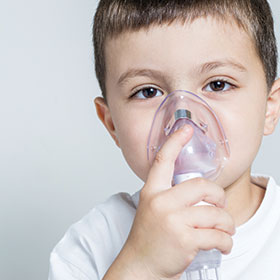Evaluating inhaler performance using idealised throats
Posted: 10 March 2015 |
The development of orally-inhaled drug products is a complex endeavour spanning multiple technical and medical fields. For the treatment of respiratory diseases such as asthma and chronic obstructive pulmonary disease (COPD), the inhalation delivery route permits the drug to be directly targeted to the afflicted organ, namely the lung. As such, a key characteristic of any inhaler or inhalation delivery device is the quantity of drug that is delivered to the lung each time the device is used.


However, efficiently delivering a drug to the lungs is not a straightforward task; the vast majority of commercial inhalers deposit a significant amount of their emitted dose in the upper (mouth and throat) airways. Consequently, in the development of orally-inhaled drugs, limiting mouth-throat deposition is desirable both for maximising lung dose and for limiting its relative variability. However, idealised throats can support the development of inhaled drugs as this article will show.
Inhalable drugs must be metred and dispersed into airborne suspensions appropriate for inhalation. Such suspensions, or aerosols, contain millions of respirable, micrometre-sized particles or droplets in each cubic centimetre of air. The challenge is ensuring that these particles or droplets entrain in a patient’s inspiratory airflow and manoeuvre the twists and turns of the mouth and throat airways en route to the lungs. The fraction of emitted dose depositing in the mouth and throat is a major determinant of lung dose for any given inhaler. Large fractional mouth-throat deposition not only limits the amount of drug reaching intended sites of action within the lung, but also increases variability in lung dose between subjects, as well as day-to-day variability for a given subject.
In vitro deposition measurements
Quantification of mouth-throat versus lung deposition for inhaled drugs has historically come from in vivo scintigraphy studies. Benchtop, or in vitro, measurements have in contrast been used primarily for quality control purposes, with a few exceptions. With this in mind, it is understandable that standard induction ports described in compendial test methods to connect inhalers to particle sizing instruments bear little resemblance to the human mouth-throat anatomy. The intention of these induction ports is to provide a standardised, simple interface through which to actuate inhalers during routine testing, and not to mimic aerosol deposition in human upper airways. In contrast, in the context of expanded in vitro testing where the goal is to mimic mouth-throat deposition that would occur in vivo, it has been well established that the standard European Pharmacopeia (Ph. Eur.)/United States Pharmacopoeia (USP) induction port (described for example in Ph. Eur. Section 2.9.18 ‘Preparations for Inhalation’) is an inadequate representation of the upper airways2.
Given this limitation of standard induction ports, several groups have made extensive efforts over the past two decades to develop alternative, more representative models of the mouth and throat airways. These include use of multiple realistic airway replicas derived from medical imaging, carefully selected to represent high, medium, and low deposition fractions within the range of values typical of adults3, as well as geometric scaling of a single realistic airway replica to small and large sizes to represent 95% confidence limits for mouth-throat deposition in adults4. An alternative approach is to develop idealised models of the upper airways that accurately mimic the predominant air flow patterns that determine aerosol deposition in realistic geometries, while preserving the ease of manufacture and robustness of standardised induction ports. This approach can be considered as an intermediate between use of the unrealistic but standardised Ph. Eur/USP induction port and use of realistic airway replicas. The usefulness of such a balance between ease of use and clinical representativeness is described below through the example of the Alberta family of idealised throats.
The Alberta Idealised Throat
The AIT is the result of more than a decade of research performed at the Aerosol Research Laboratory of Alberta (University of Alberta, Canada) aimed at improving the ability of in vitro aerosol test methods to accurately predict in vivo deposition behaviour. The adult AIT is manufactured commercially by Copley Scientific (Nottingham, UK) to close tolerances in metal. The use of metals in manufacture of throat models has several advantages over use of plastics: conductive metal surfaces prevent falsely elevated mouth-throat deposition associated with electrostatic patch-charge found in insulating plastic replicas; metal surfaces do not interfere with the extraction of deposited materials for assay using high-performance liquid chromatography (HPLC); and metals offer a significant advantage in general durability over long-term, repeated use. The adult AIT has been the subject of extensive fundamental and applied study, and has demonstrated close agreement between mouth-throat deposition measured in vitro with average in vivo values measured in clinical studies for both pressurised metred-dose inhalers (pMDIs) and dry power inhalers (DPIs). As a result, the adult AIT is widely used in development of orally-inhaled drug products, providing a valuable tool for rapid, benchtop assessment of inhaler performance in early stages of device and formulation design. In addition to the standard adult AIT that interfaces with inhaler mouthpieces, an alternate version has recently been developed incorporating an idealised facial geometry to permit testing with facemasks.
Idealised throats representing children
Inhaled drugs are frequently prescribed to children, and interest in assessing and optimising inhaler performance for use by children is widespread. However, European Medicines Agency (EMA) guidelines unequivocally state that in vivo lung deposition studies are not appropriate to perform in children5. Consequently, following the introduction of the adult AIT, the desire amongst industry and academics for a similar idealised throat representing the paediatric population was clear. The ‘Alberta Idealised Child Throat’ was subsequently developed. The child throat geometry was achieved by uniformly scaling-down the adult AIT based on oropharyngeal airway dimensions measured for children aged six-to-fourteen years and in vitro aerosol deposition experiments performed in replicas of these same airways6. Deposition measured in the idealised child throat is thus intended to mimic average in vivo mouth-throat deposition within the six-to-fourteen year age range. Validation testing demonstrated that in vitro deposition measured in the idealised child throat compared well with average in vivo mouth-throat deposition for a paediatric metered dose inhaler in asthmatic children aged eight-to-fourteen years, and for a dry powder inhaler in children with cystic fibrosis aged 6-16 years7. As for the adult AIT, an alternate version of the idealised child throat has recently been developed incorporating an idealised facial geometry for testing with facemasks.
Of course children below the lower age limit for which the idealised child throat was developed, that is below six years of age, may also be prescribed inhalers. EMA guidelines suggest that equivalence between two inhaled products may need to be demonstrated separately in studies involving sub-groups of children aged less than two years, two-to-five years, and six-to-twelve years5. The age range for the idealised child throat lines up well with the oldest of these three sub-groups; however, the idealised child throat should not be used to infer inhaler performance for pre-school aged children (two-to-five years old) and younger. It is likely that for these younger ages, a further uniform scaling of the adult AIT is inappropriate given differences in oropharyngeal geometry between young children and adults8. Rather, idealised airway geometries may need to be developed independent of the adult AIT, as is described for very young children below.
Idealised throats representing infants
Very young children, of less than approximately two years of age, cannot inhale orally through a mouthpiece. Instead, inhaled drugs are commonly delivered via nasal breathing through a facemask. In this case, a very different geometry from the adult AIT or the idealised child throat is required. The ‘Alberta Idealised Infant Throat’ (Figure 1) was recently developed through detailed investigation and numerical analysis of computed tomography (CT) scans of the nasal geometries of infants aged three-to-eighteen months, as well as consideration of in vitro aerosol deposition experiments performed in replicas of these airways9. Deposition measured in vitro in the idealised infant throat mimics average upper airway deposition in the three-to-eighteen month age range. The inclusion of a facial geometry with the idealised infant throat permits testing with facemasks, though facemasks should be sealed to the facial surface during testing to prevent clinically unrealistic leakage10. The potential use of the idealised infant throat as a reference geometry in assessing inhalation drug delivery to infants may be particularly advantageous given the challenges associated with performing in vivo testing in very young children.
Perspectives for future development
The three idealised throats described above – adult, child, and infant – have been developed to permit clinically relevant in vitro testing to be performed on inhaled drugs across a wide age range. A notable gap exists for pre-school aged children between approximately two-to-five years old. The existing idealised child throat should not be used to predict in vivo mouth-throat deposition in this age range given that it was developed and validated for older children. To date, attempts to scale the adult AIT down to sizes representative of pre-school aged children have produced unsatisfactory results11. It may well be that for this age group an independent idealised geometry needs to be developed, as was done for infants.
Additionally, delivery of inhaled drugs to newborns is of considerable interest, such that extension of the idealised infant throat down to younger ages through application of scaling factors should be explored. Alternatively, there may be need to develop an independent airway geometry representative of the newborn population. In either case, the availability of a reference geometry for use in early-stage development of inhaled drug products for newborns could prove useful given, as for infants, the challenges associated with performing in vivo deposition studies of any kind in newborns.
In summary, the existing adult, child, and infant idealised throats span a wide range of ages and serve to support and accelerate development of inhaled drugs. Continued work focused on extending in vitro modelling capabilities to preschool-aged children and newborns is anticipated to aid in assessing delivery of inhaled drugs to an even wider range of ages.
References
- Borgstrom L, Olsson B, and L Thorsson. 2006. Degree of throat deposition can explain the variability in lung deposition of inhaled drugs. Journal of Aerosol Medicine 19(4):473-483.
- Peter R. Byron, Michael Hindle, Carlos F. Lange, P. Worth Longest, Donald McRobbie, Michael J. Oldham, Bo Olsson, Charles G. Thiel, Herbert Wachtel, and Warren H. Finlay. Journal of Aerosol Medicine and Pulmonary Drug Delivery. 2010, 23(S2): S59-S69
- Patricia K.P. Burnell, Lars Asking, Lars Borgström, Steve C. Nichols, Bo Olsson, David Prime, and Ian Shrubb. Journal of Aerosol Medicine. September 2007, 20(3)
- Delvadia RR, Longest PW, and Byron PR. In vitro tests for aerosol deposition. I: Scaling a physical model of the upper airways to predict drug deposition variation in normal humans, Journal of Aerosol Medicine and Pulmonary Drug Delivery. 2012, 25(1):32-40
- Golshahi L, and Finlay WH. An idealized child throat that mimics average pediatric oropharyngeal deposition. Aerosol Science and Technology. 2012, 46(5):i-iv.
- Ruzycki CA, Golshahi L, Vehring R, and Finlay WH. Comparison of in vitro deposition of pharmaceutical aerosols in an idealized child throat with in vivo deposition in the upper respiratory tract of children. Pharmaceutical Research. 2014, 31(6):1525-1535.
- European Medicines Agency. Guideline on the requirements for clinical documentation for orally inhaled products (OIP) including the requirements for demonstration of therapeutic equivalence between two inhaled products for use in the treatment of asthma and chronic obstructive pulmonary disease (COPD) in adults and for use in the treatment of asthma in children and adolescents. 2009. Doc. Ref. CPMP/EWP/4151/00 Rev. 1.
- Wachtel, H., Bickmann, D., Breitkreutz, J., Langguth, P. (2010) “Can Pediatric Throat Models and Air Flow Profiles Improve Our Dose Finding Strategy”, in Respiratory Drug Delivery 2010, pp. 195-204, ed. R.N. Dalby, P.R. Byron, J. Peart, J.D. Suman, S.J. Farr and P.M. Young.
- Javaheri E, Golshahi L, and Finlay WH. An idealized geometry that mimics average infant nasal airway deposition. Journal of Aerosol Science. 2013. 55:137-148.
- Carrigy NB, O’Reilly C, Schmitt J, Noga M, and Finlay WH. Effect of facial material softness and applied force on face mask dead volume, face mask seal, and inhaled corticosteroid delivery through an idealized infant replica. Journal of Aerosol Medicine and Pulmonary Drug Delivery. 2014. 27(4):298-298.
- Warren H. Finlay, Conor A. Ruzycki, Laleh Golshahi, and Reinhard Vehring, “Validating and Scaling the Alberta Idealized Child Throat”, in Respiratory Drug Delivery 2014, pp. 303-310, May 4-8, 2014, Puerto Rico. Ed. Ed. R. N. Dalby, P. R. Byron, J. Peart, J. D. Suman, S. J. Farr & P. M. Young. Davis Healthcare Int’l Publishing, River Grove, Illinois.
Biographies
Andrew Martin joined the University of Alberta as an Assistant Professor of Mechanical Engineering in January 2014. Previously, he held industrial research and development positions in France and in the US. He holds a PhD in Mechanical Engineering from the University of Alberta (2008). He has made significant contributions to the field of inhalation drug delivery, both in the academic and industry setting, through his scientific publications, patents, and participation in international meetings. In recognition of these contributions, he was awarded the International Society for Aerosols in Medicine’s Young Investigator Award (2013).
Warren Finlay has been a Professor of Mechanical Engineering at the University of Alberta since 1987 and is the founding Director of the Aerosol Research Laboratory of Alberta (ARLA). He obtained his PhD in Mechanical Engineering from Stanford University (1987). He has published more than 140 highly-respected journal articles and is an Editor of Aerosol Science and Technology. He is the author of the Elsevier-published book: ‘The Mechanics of Inhaled Pharmaceuticals Aerosols: An Introduction’. He was recently inducted as a Fellow of the Royal Society of Canada, and is the recipient of various other academic awards for outstanding achievement, including the APEGA Centennial Leadership Award, the Thomas T. Mercer prize, and a lifetime designation as a Fellow of the Engineering Institute of Canada and the American Association for Aerosol Research. He works extensively with companies globally on drug delivery to the lungs and is devoted to the fight against lung disease.









